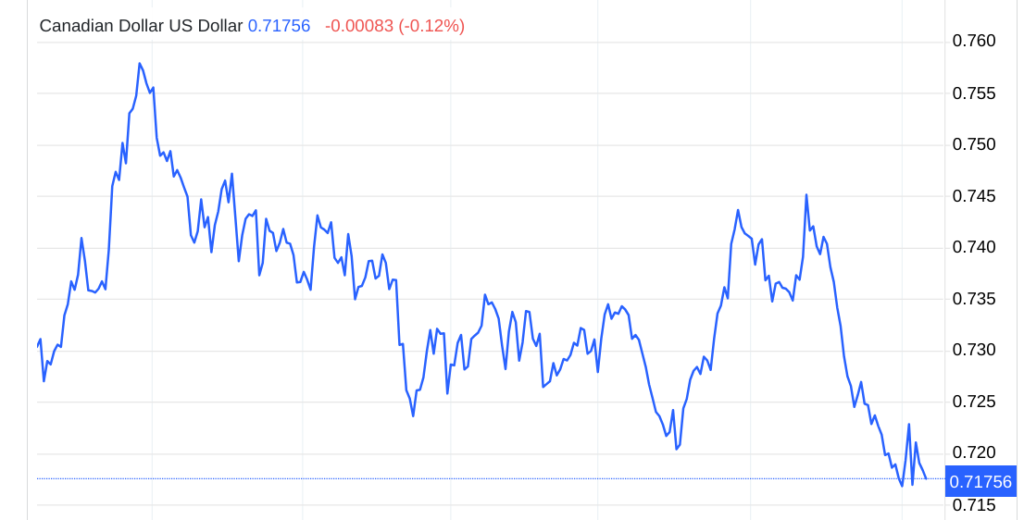Articles & Videos
Canada’s Weak Loonie: Implications for the Economy and SMEs

As of late 2024, the Canadian dollar, affectionately known as the “loonie,” has hit a low not seen in over four years, trading at approximately 72 cents to the US dollar. This depreciation has generated mixed reactions across Canada, with impacts rippling through the economy, affecting consumers and businesses in various ways. Let’s dive into the reasons behind the loonie’s slump of 1.11% across the last 12 months, the broader economic implications, and how Canadian businesses can adapt to this challenging landscape.

Source: Trading Economics. Accessed 12.11.2024.
Why Is the Loonie Declining?
Several macroeconomic factors are contributing to the loonie’s current state, among them:
Interest Rate Divergence
The Bank of Canada’s cautious approach to interest rate hikes contrasts with the more aggressive stance taken by the U.S. Federal Reserve. Higher U.S. rates increase the demand for USD-denominated assets, putting pressure on the CAD to depreciate.
Global Economic Slowdown Concerns
As global markets experience uncertainty, particularly with China’s economic struggles and global inflation concerns, riskier currencies like the CAD are becoming less attractive.
Commodity Price Volatility
While Canada is a significant exporter of commodities like oil, the global volatility in oil prices, partly due to shifts in global energy demands, has put downward pressure on the CAD, which tends to perform better when commodity prices are high.
Economic Implications of a Weaker Canadian Dollar
A depreciating loonie has a broad range of effects on the economy, some of which are beneficial, while others pose significant challenges. Here are the primary economic implications:
Inflationary Pressures
The most immediate consequence of a weak loonie is its inflationary impact. Imported goods become more expensive, raising costs for everything from electronics to groceries. Canadians could see a marked increase in the cost of living, particularly for goods that are not domestically produced.
Mixed Impact on Exports
A weak dollar can be advantageous for Canadian exporters, as it makes Canadian goods more competitively priced abroad. Industries reliant on exports, such as agriculture, forestry, and manufacturing, may benefit. However, if the global demand slows, Canadian exports might not fully capitalize on this competitive edge.
Increased Tourism Appeal
For the Canadian tourism industry, a lower dollar may serve as a boon. Visitors from the U.S. and other countries will find Canada to be a more affordable destination, potentially boosting tourism-related revenue.
Investment Uncertainty
Foreign investment in Canada may waver, especially if investors are drawn to higher-yield assets elsewhere. A prolonged weak dollar might discourage foreign direct investment, potentially impacting growth prospects in sectors like technology and infrastructure.
Impact on Canadian Businesses and SMEs
For Canadian businesses, particularly small and medium-sized enterprises (SMEs), a weaker dollar presents both opportunities and challenges. Here are some of the main ways the loonie’s low value could affect Canadian businesses:
Higher Import Costs for SMEs
SMEs that rely heavily on imported goods or raw materials will experience rising costs. For businesses with thin margins, such as retail and food services, these cost increases could directly impact profitability, forcing them to either absorb the costs or raise prices for consumers.
Supply Chain Disruptions
The cost and complexity of maintaining international supply chains rises with a weaker dollar. SMEs may find it more challenging to source affordable goods from abroad, especially if they have limited buying power compared to larger competitors. In response, businesses might consider finding local suppliers, though this may not be viable in all cases.
Competitive Edge for Export-Oriented SMEs
For SMEs that export goods or services, the weaker loonie provides a chance to expand market reach. These businesses can capitalize on competitive pricing in foreign markets, allowing them to potentially increase sales and build stronger relationships with international clients.
Difficulty in Financing and Investment
With a weaker dollar, borrowing costs and foreign exchange risks rise, making it challenging for SMEs to obtain affordable financing. This can hinder growth initiatives, especially for small businesses looking to expand their operations or invest in innovation. Canadian businesses have struggled with waning productivity versus other countries; importing the machinery and IT equipment needed to address this has gotten more expensive with the weak currency, making it near impossible for many businesses to invest and grow.
Talent Acquisition and Retention
With high living costs and increased economic uncertainty, Canadian businesses may find it more challenging to attract and retain talent. A weak dollar could lead to demands for higher wages to offset inflation, further stretching the budgets of small businesses.
Strategies for Canadian SMEs to Navigate the Weak Loonie
In light of these challenges, here are some strategies Canadian SMEs can adopt to mitigate the impact of a weak dollar:
Focus on Export Growth
Export-oriented SMEs should consider increasing their marketing efforts in foreign markets, especially the U.S., to take advantage of favorable exchange rates. Adopting digital marketing strategies can help SMEs reach a larger audience without incurring substantial costs.
Optimize Supply Chains
SMEs should review their supply chains to identify potential cost-saving opportunities. Engaging in bulk purchasing, establishing long-term contracts with suppliers, or shifting to local suppliers where possible could reduce import dependency and shield businesses from currency fluctuations.
Embrace Technology and Automation
Investing in technology to improve efficiency and reduce costs can be especially valuable. Automation can help cut down on operational costs, and leveraging data analytics can optimize decision-making, which may be crucial in a volatile economic environment.
Diversify Revenue Streams
Diversification, both in terms of product offerings and market reach, can provide a buffer against currency-related risks. For example, businesses could consider adding complementary products or exploring markets outside of North America.
Consider Hedging
SMEs exposed to currency fluctuations may benefit from hedging strategies to mitigate risks associated with a weaker loonie. Consulting with financial experts on forward contracts or options can help protect against unexpected exchange rate shifts.
Enhanced Customer Engagement
With rising costs, customer loyalty becomes paramount. SMEs should focus on improving customer experiences, offering personalized services, and strengthening brand loyalty to retain customers, even in a high-cost environment.
What’s Next for the Loonie and Canadian SMEs?
Unfortunately, the signs for the near term are disheartening, particularly as the recent election win by Trump may serve to exacerbate the situation, encouraging trade wars, lowering US oil prices and pushing the loonie further south. Economic indicators point to the downward trend continuing for some time before starting to improve.
While the loonie’s current low is concerning, currency fluctuations are a common part of the global economy. Some factors, such as global energy prices or U.S. economic policy, are outside Canada’s control. However, by staying agile and proactive, Canadian businesses, especially SMEs, can navigate this period of volatility and emerge resilient.
For policymakers, the focus should be on stabilizing inflation and fostering an economic environment conducive to SME growth. As SMEs form the backbone of Canada’s economy, supporting them in weathering the impacts of a weak dollar is essential for long-term economic stability and prosperity.
In the coming months, all eyes will be on the Bank of Canada’s decisions and broader economic indicators to gauge whether the loonie will rebound or continue to hover at its current levels. In the meantime, Canadian SMEs should prioritize adaptability and resilience to navigate the uncertainties of a fluctuating loonie effectively.
Reach out to our Canadian team to explore the funding options available to your business for investment and additional working capital in the current climate. With our presence in the UK, Sallyport is ideally placed to support Canadian businesses with flexible funding to pursue their expansion and exporting ambitions.
Search
News
$1M Funding Fuels Agri-Business Growth Across Borders
Sallyport is pleased to announce a new partnership with a Canadian agriculture business, providing a $1,000,000 Accounts Receivable facility to…
Read MoreFueling EdTech Growth with $5.5M in Tailored Financing
Sallyport is excited to support a forward-thinking education technology company with a $5.5M combined Asset-Based Lending facility, including Accounts Receivable…
Read MoreArticles
Canadian Business and The 2022 Federal Budget – Key Takeaways
It’s fair to say small businesses didn’t feature massively in the Canadian 2022 Federal Budget proposed last week. Although there…
Read MoreCould Trade Credit Insurance Save Your Business?
Trade credit insurance or accounts receivable insurance is a type of corporate insurance policy within the Property and Casualty business…
Read MoreVideos
AG Machining Client Testimonial
AG Machining Client Testimonial
View Now



